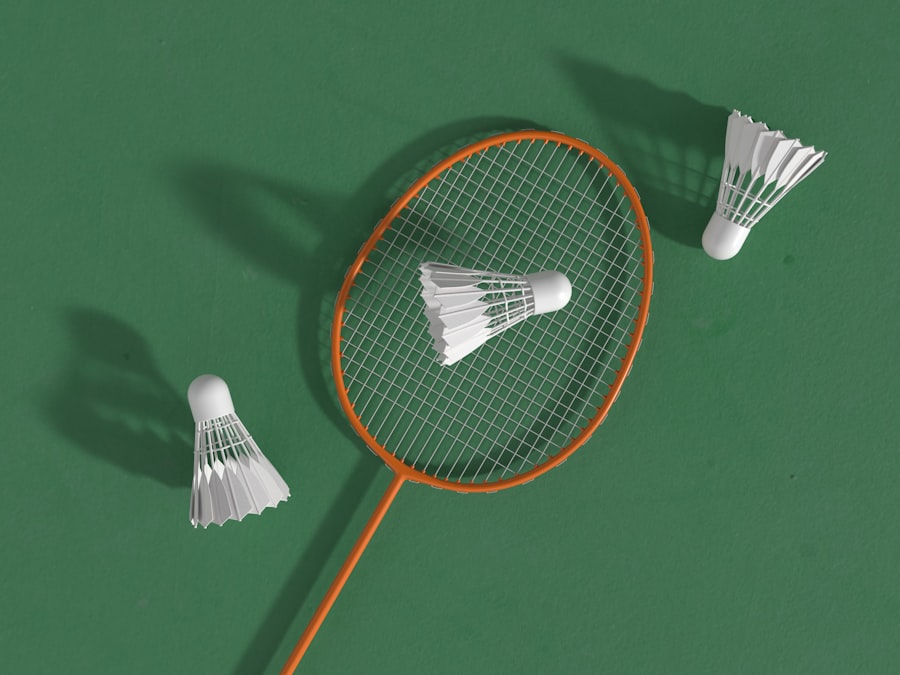Download links
How to install Mastering the Art of Badminton: Tips for Success APK?
1. Tap the downloaded Mastering the Art of Badminton: Tips for Success APK file.
2. Touch install.
3. Follow the steps on the screen.
Description
Badminton is a fast-paced racquet sport that has gained immense popularity worldwide, characterized by its unique blend of agility, strategy, and precision. The game is played either in singles or doubles format, with players using a racquet to hit a shuttlecock over a net. The objective is to score points by landing the shuttlecock in the opponent’s court while preventing them from doing the same.
The sport’s origins can be traced back to ancient civilizations, but it was formalized in the mid-19th century in England, where it quickly evolved into the competitive game we know today. The court dimensions are crucial to understanding the game. A standard badminton court measures 13.4 meters long and 6.1 meters wide for doubles play, while singles play narrows the width to 5.18 meters.
The net height is set at 1.55 meters at the center, creating a challenging barrier that players must overcome with skillful shots. The scoring system has also evolved; currently, matches are played to 21 points, with players needing to win by a margin of at least two points. This scoring format encourages aggressive play and strategic shot placement, making every point crucial in determining the outcome of a match.
Key Takeaways
- Badminton is a fast-paced racket sport played with a shuttlecock, requiring agility, speed, and strategy.
- Proper footwork and movement are essential for success in badminton, including quick changes in direction and balance.
- Mastering essential badminton strokes such as the clear, drop shot, smash, and drive is crucial for competitive play.
- Improving speed and agility through drills and exercises can give players an edge on the court.
- Enhancing strategy and game sense involves understanding opponents’ weaknesses and adapting tactics during play.
Developing Proper Footwork and Movement
Footwork is often regarded as one of the most critical aspects of badminton, as it directly influences a player’s ability to reach the shuttlecock effectively and execute shots with precision. Good footwork allows players to maintain balance and positioning, enabling them to respond quickly to their opponent’s shots. A fundamental principle of badminton footwork is the use of the “ready position,” where players stand with their feet shoulder-width apart, knees slightly bent, and racquet held in front of them.
This stance prepares them for quick lateral movements and forward or backward sprints. To develop effective footwork, players should practice various movement drills that emphasize agility and speed. One common drill involves shadowing, where players mimic the movements they would make during a match without hitting a shuttlecock.
This exercise helps reinforce muscle memory and improves overall coordination. Additionally, incorporating ladder drills can enhance foot speed and agility, allowing players to navigate the court more efficiently. By focusing on footwork, players can significantly improve their ability to position themselves optimally for each shot, ultimately leading to better performance during matches.
Mastering the Essential Badminton Strokes

A comprehensive understanding of badminton strokes is essential for any player aspiring to excel in the sport. The primary strokes include the forehand and backhand drives, clears, drops, smashes, and net shots. Each stroke serves a specific purpose and requires distinct techniques for execution.
For instance, the forehand clear is executed by swinging the racquet from low to high, generating power and height to send the shuttlecock deep into the opponent’s court. This stroke is particularly useful for pushing opponents back and creating space for attacking shots.
Players must learn to rotate their wrists effectively while maintaining control over the shuttlecock’s trajectory. Mastering these strokes involves repetitive practice and an understanding of when to employ each shot strategically during a match.
For example, a well-timed drop shot can catch an opponent off guard, while a powerful smash can put them on the defensive. By honing these essential strokes, players can develop a versatile game that keeps opponents guessing and enhances their overall effectiveness on the court.
Improving Your Speed and Agility
| Exercise | Reps | Sets | Rest |
|---|---|---|---|
| Sprint | 10 | 3 | 2 minutes |
| Ladder Drills | 20 | 3 | 1 minute |
| Box Jumps | 15 | 3 | 1.5 minutes |
| Shuttle Runs | 10 | 3 | 2 minutes |
Speed and agility are paramount in badminton, where split-second decisions can determine the outcome of a rally. Players must be able to accelerate quickly in any direction while maintaining balance and control over their movements. To enhance speed, athletes can engage in sprinting drills that focus on short bursts of acceleration followed by quick deceleration.
These drills simulate the rapid movements required during a match and help build explosive power in the legs. Agility training often incorporates lateral movements and quick changes of direction. Cone drills are particularly effective for this purpose; players can set up cones in various patterns and practice weaving through them at high speed.
This not only improves footwork but also enhances overall body coordination.
By prioritizing speed and agility training, badminton players can gain a significant advantage over their opponents.
Enhancing Your Strategy and Game Sense
Strategic thinking is an integral component of badminton that separates skilled players from novices. Understanding your opponent’s strengths and weaknesses allows you to tailor your gameplay accordingly. For instance, if an opponent struggles with high shots, employing more clears and smashes can exploit this weakness effectively.
Conversely, if they excel at net play, it may be wise to focus on deep shots that push them away from their comfort zone. Game sense also involves recognizing patterns during play. Experienced players often develop an instinct for predicting their opponent’s next move based on previous shots or positioning on the court.
This anticipation allows them to prepare mentally and physically for what’s coming next. Practicing match scenarios with a partner can help develop this skill; by simulating different situations, players can learn to adapt their strategies in real-time during actual matches. Ultimately, enhancing strategic thinking and game sense leads to more informed decision-making on the court.
Perfecting Your Serve and Return

The serve is one of the most critical aspects of badminton as it sets the tone for each rally. A well-executed serve can put immediate pressure on your opponent while providing you with an advantageous position from which to attack. There are several types of serves in badminton: high serves, low serves, flick serves, and drive serves, each serving different tactical purposes.
High serves are typically used in singles play to push opponents back, while low serves are more common in doubles play to create opportunities for quick attacks at the net. Equally important is mastering the return of serve. A strong return can shift momentum in your favor right from the start of a rally.
Players should focus on reading their opponent’s serve and positioning themselves accordingly for an effective return. Practicing various return techniques—such as drives or net shots—can help players respond effectively regardless of how their opponent serves. By dedicating time to perfecting both serving and returning skills, players can gain a significant edge over their competition.
Mental Preparation and Focus
Mental preparation is often overlooked in sports training but plays a crucial role in achieving success in badminton. The ability to maintain focus during matches can significantly impact performance levels; distractions or lapses in concentration can lead to unforced errors or missed opportunities. Visualization techniques are commonly employed by athletes to enhance mental preparedness; by picturing themselves executing successful shots or winning crucial points, players can build confidence and reduce anxiety.
Additionally, developing a pre-match routine can help establish a focused mindset before stepping onto the court. This routine might include specific warm-up exercises, breathing techniques, or even listening to music that energizes them. During matches, practicing mindfulness—staying present in each moment rather than dwelling on past mistakes or worrying about future points—can help maintain composure under pressure.
By prioritizing mental preparation alongside physical training, badminton players can cultivate resilience and enhance their overall performance.
Training and Conditioning for Badminton Success
A well-rounded training regimen is essential for achieving success in badminton; it should encompass not only skill development but also physical conditioning tailored specifically for the demands of the sport. Strength training plays a vital role in building muscle endurance and power necessary for executing powerful strokes and maintaining stability during rapid movements on the court. Exercises targeting core strength are particularly beneficial as they contribute to overall balance and control.
Incorporating cardiovascular conditioning into training routines is equally important; badminton requires sustained energy levels throughout matches that can last for extended periods. Activities such as interval training or circuit workouts can improve cardiovascular fitness while simulating match-like conditions that require quick bursts of energy followed by brief recovery periods. Flexibility training should not be neglected either; incorporating stretching routines helps prevent injuries while enhancing range of motion—both critical factors for executing various strokes effectively.
By combining skill development with comprehensive physical conditioning programs tailored specifically for badminton, players can maximize their potential on the court and achieve greater success in competitive play.
FAQs
What is badminton?
Badminton is a racquet sport played by either two opposing players (singles) or two opposing pairs (doubles), who take positions on opposite halves of a rectangular court divided by a net.
What equipment is used in badminton?
The primary equipment used in badminton includes a shuttlecock (also known as a birdie), badminton racquets, and a net. Players also typically wear appropriate athletic clothing and non-marking shoes.
What are the basic rules of badminton?
The basic rules of badminton include serving diagonally, scoring points by landing the shuttlecock within the opponent’s court, and winning a match by winning two out of three games.
What are the health benefits of playing badminton?
Playing badminton can provide numerous health benefits, including improved cardiovascular fitness, agility, coordination, and flexibility. It also helps in burning calories and improving overall physical fitness.
What are the different types of badminton shots?
Some of the different types of badminton shots include the clear, drop shot, smash, drive, and the backhand shot. Each shot has its own specific technique and purpose during a game.
What are the major badminton tournaments and events?
Some of the major badminton tournaments and events include the All England Open Badminton Championships, BWF World Championships, Thomas Cup (men’s team event), Uber Cup (women’s team event), and the Olympic Games.





